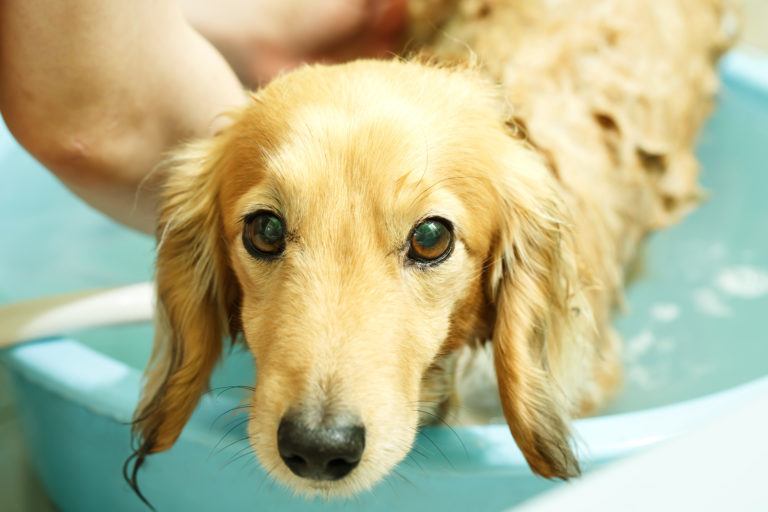
Quick Tips
- Secure your dog before a bath.
- Brush your dog.
- Rinse your dog.
- Rinse and dry thoroughly.
- Each dog breed is different.
Dogs are family, albeit furry, bunny-chasing, garbage-eating, butt-licking family. And we love them, even if they come home stinking of skunk and carrion. So you do what you’d do for your own child: take him kicking and screaming (or whimpering and bracing against the bathroom door), put him in the tub, and scrub him down.
Every dog breed is going to have a different coat and a different temperament, and how to groom your dog depends a lot on that. Pay close attention to your dog, and cater bath time to his needs. Make sure that the temperature of the water or the air isn’t too cold or too hot, that the bath surface isn’t slippery, that an aggressive dog is properly secured, a nervous dog properly comforted, and an enthusiastic water breed, like a Labrador, is properly contained. You’re responsible for the health, wellbeing, and general un-stinkiness of your dog, so make sure you’re doing bath time correctly.
Steps to Cleaning a Dog
 Secure your dog before a bath. This means two things. First, you must pick the right place to give your dog a bath. Your Newfoundland probably won’t fit in the kitchen sink, and you might lose your Chihuahua in your Jacuzzi tub, so pick the right place for the size and breed of you dog. As a Lab/mix owner myself, I prefer the kiddie pool during the warm months and the bathtub in the colder months. However, wherever you choose to clean your dog, make sure that the dog is safely secured during bath time. An excitable dog can hurt itself jumping from the kitchen sink or running from the backyard kiddie pool into traffic. Never leave your dog unattended during bath time.
Secure your dog before a bath. This means two things. First, you must pick the right place to give your dog a bath. Your Newfoundland probably won’t fit in the kitchen sink, and you might lose your Chihuahua in your Jacuzzi tub, so pick the right place for the size and breed of you dog. As a Lab/mix owner myself, I prefer the kiddie pool during the warm months and the bathtub in the colder months. However, wherever you choose to clean your dog, make sure that the dog is safely secured during bath time. An excitable dog can hurt itself jumping from the kitchen sink or running from the backyard kiddie pool into traffic. Never leave your dog unattended during bath time.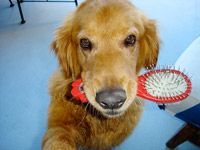 Brush your dog. The best way to clean your dog is to brush your dog. This should be done on a regular basis anyway, to get rid of loose hair and dirt and to prevent matting. This is critical before you give your dog a bath. In fact, it’s like not scraping your plates before putting them into the dishwasher: you’ll probably end up mashing more crud around than you get rid of. Breeds with short hair will require much less brushing than say, a German Shepherd or Golden Retriever. If your dog was sprayed by a skunk, this might be a step you could skip and go right to the dousing. But regular brushing is the first step to grooming your dog at home and can help get rid of itchy skin and excessive shedding, and make your dog more happy and comfortable.
Brush your dog. The best way to clean your dog is to brush your dog. This should be done on a regular basis anyway, to get rid of loose hair and dirt and to prevent matting. This is critical before you give your dog a bath. In fact, it’s like not scraping your plates before putting them into the dishwasher: you’ll probably end up mashing more crud around than you get rid of. Breeds with short hair will require much less brushing than say, a German Shepherd or Golden Retriever. If your dog was sprayed by a skunk, this might be a step you could skip and go right to the dousing. But regular brushing is the first step to grooming your dog at home and can help get rid of itchy skin and excessive shedding, and make your dog more happy and comfortable.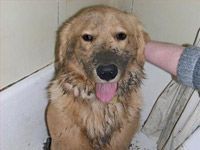 Rinse your dog. Beyond brushing your dog, you should also thoroughly soak him. Think of this as the pre-rinse to get rid of hair, dirt, dead skins cells, skin oil, and whatever your dog has recently rolled in. My dog has a penchant for horse poop and rodent carcasses. This will actually help to clean your dog instead of mashing that crud around. And you want to get rid of horse poop/skunk oil/swamp water/muskrat grease instead of soaking your dog in a big stew of it. Be sure that your dog is saturated down to the skin. Many dogs have a protective undercoat that helps insulate them against exactly that to prevent hypothermia. But since you’re probably indoors, in your bathtub, it’s okay.
Rinse your dog. Beyond brushing your dog, you should also thoroughly soak him. Think of this as the pre-rinse to get rid of hair, dirt, dead skins cells, skin oil, and whatever your dog has recently rolled in. My dog has a penchant for horse poop and rodent carcasses. This will actually help to clean your dog instead of mashing that crud around. And you want to get rid of horse poop/skunk oil/swamp water/muskrat grease instead of soaking your dog in a big stew of it. Be sure that your dog is saturated down to the skin. Many dogs have a protective undercoat that helps insulate them against exactly that to prevent hypothermia. But since you’re probably indoors, in your bathtub, it’s okay.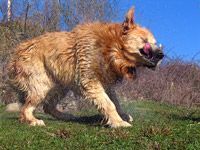 Rinse and dry thoroughly. Yes, it seems painfully obvious that you must rinse and dry your dog. But it’s important that you rinse and dry your dog all the way. Any remnants of dog shampoo on your dog’s skin can cause dryness and itching. And that means an unhappy and uncomfortable canine, one much more likely to find some soothing mud to roll in right after the bath. And, if you don’t dry your dog thoroughly (or allow the dog to dry in a clean, warm place), undercoat and all, your dog is at risk for hypothermia. A wet undercoat is a lot like wet long johns. Yeah, uncomfortable at best, but dangerous when exposed to the elements.
Rinse and dry thoroughly. Yes, it seems painfully obvious that you must rinse and dry your dog. But it’s important that you rinse and dry your dog all the way. Any remnants of dog shampoo on your dog’s skin can cause dryness and itching. And that means an unhappy and uncomfortable canine, one much more likely to find some soothing mud to roll in right after the bath. And, if you don’t dry your dog thoroughly (or allow the dog to dry in a clean, warm place), undercoat and all, your dog is at risk for hypothermia. A wet undercoat is a lot like wet long johns. Yeah, uncomfortable at best, but dangerous when exposed to the elements.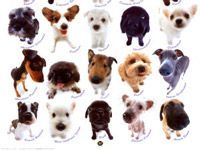 Each dog breed is different. Dogs like an American Staffordshire Terrier require little more than a brushing and a good rubdown with a wet cloth, but others require much more maintenance. A Chow, Akita, Sheepdog, or Golden Retriever is going to require different grooming techniques than a Chihuahua or a Boston Terrier. Keep that in mind when choosing your dog shampoo, your dog bath area, and your decision whether or not to just pay a groomer to do it for you.
Each dog breed is different. Dogs like an American Staffordshire Terrier require little more than a brushing and a good rubdown with a wet cloth, but others require much more maintenance. A Chow, Akita, Sheepdog, or Golden Retriever is going to require different grooming techniques than a Chihuahua or a Boston Terrier. Keep that in mind when choosing your dog shampoo, your dog bath area, and your decision whether or not to just pay a groomer to do it for you.
Dog Grooming at Home or Away
Yes, you can pay someone else to do it. Giving a dog a bath isn’t always very easy, particularly if you have a nervous, aggressive, really large, really hairy, really sensitive, or really energetic dog. It might just be worth the money to have a professional groomer clean your dog. You can find local groomers in the phone book, or through your veterinarian’s office, local animal shelters, humane societies, and even local dog trainers and boarders. They can probably get a good tooth brushing, ear cleaning, and clipping to boot. You can extend the minimization of dog smell between professional grooming appointments by giving your dog a dry bath with baking soda. Just dust on and brush through. Yeah, that’s way easier than wrestling a 120-pound Newfoundland into a kiddie pool when he really doesn’t want to be there.
Cleaning a Dog Naturally
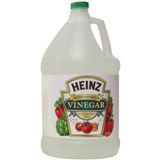 Vinegar. Yes, vinegar really does do everything. You can clean things with vinegar, get rid of odors with vinegar, and even get rid of skunk smell from your dog with white vinegar. It’s cheaper by volume than tomato juice, and it is mildly acidic, so it can cut the oily skunk spray, and it won’t turn your dog tomato-tinted. Your dog may smell a bit like a pickle, but it’s better than skunk. Be sure to avoid getting white vinegar in your dog’s eyes, nose, or ears. You can get it pretty much anywhere, or order the vinegar straight from Amazon.
Vinegar. Yes, vinegar really does do everything. You can clean things with vinegar, get rid of odors with vinegar, and even get rid of skunk smell from your dog with white vinegar. It’s cheaper by volume than tomato juice, and it is mildly acidic, so it can cut the oily skunk spray, and it won’t turn your dog tomato-tinted. Your dog may smell a bit like a pickle, but it’s better than skunk. Be sure to avoid getting white vinegar in your dog’s eyes, nose, or ears. You can get it pretty much anywhere, or order the vinegar straight from Amazon.
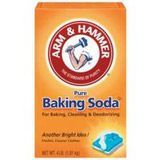 Baking Soda.Among the million other uses for baking soda, you can use it to give your dog a dry bath. This will not only clean your dog and get rid of dog odors, but it will help give you a sparkling white bathtub. Either dust it over your dog’s coat and brush through, or add it to his bath water. Then later you can mix it with vinegar and red food coloring for your homemade volcano project.
Baking Soda.Among the million other uses for baking soda, you can use it to give your dog a dry bath. This will not only clean your dog and get rid of dog odors, but it will help give you a sparkling white bathtub. Either dust it over your dog’s coat and brush through, or add it to his bath water. Then later you can mix it with vinegar and red food coloring for your homemade volcano project.